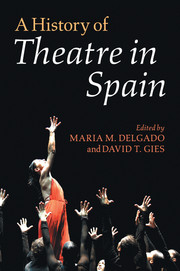Book contents
- Frontmatter
- Contents
- Illustrations
- Contributors
- Acknowledgements
- Introduction
- 1 The challenges of historiography
- 2 Lope de Vega, Calderón de la Barca and Tirso de Molina
- 3 The world as a stage
- 4 Playing the palace
- 5 The art of the actor, 1565–1833
- 6 Theatrical infrastructures, dramatic production and performance, 1700–1759
- 7 Popular theatre and the Spanish stage, 1737–1798
- 8 Theatre of the elites, neoclassicism and the Enlightenment, 1750–1808
- 9 Actors and agency in the modern era, 1801–2010
- 10 Zarzuela
- 11 Nineteenth-century Spanish theatre
- 12 Copyright, buildings, spaces and the nineteenth-century stage
- 13 Modernism and the avant-garde in fin-de-siècle Barcelona and Madrid
- 14 Continuity and innovation in Spanish theatre, 1900–1936
- 15 Theatrical activities during the Spanish Civil War, 1936–1939
- 16 Theatre, colonialism, exile and the Americas
- 17 Theatre under Franco (1939–1975)
- 18 Flamenco
- 19 Nationalism, identity and the theatre across the Spanish state in the democratic era, 1975–2010
- 20 Directors and the Spanish stage, 1823–2010
- 21 This evolution is still ongoing
- 22 Theatre as a process of discovery
- 23 Theatre is the art of the future
- Select bibliography
- Index
- References
15 - Theatrical activities during the Spanish Civil War, 1936–1939
Published online by Cambridge University Press: 05 June 2012
- Frontmatter
- Contents
- Illustrations
- Contributors
- Acknowledgements
- Introduction
- 1 The challenges of historiography
- 2 Lope de Vega, Calderón de la Barca and Tirso de Molina
- 3 The world as a stage
- 4 Playing the palace
- 5 The art of the actor, 1565–1833
- 6 Theatrical infrastructures, dramatic production and performance, 1700–1759
- 7 Popular theatre and the Spanish stage, 1737–1798
- 8 Theatre of the elites, neoclassicism and the Enlightenment, 1750–1808
- 9 Actors and agency in the modern era, 1801–2010
- 10 Zarzuela
- 11 Nineteenth-century Spanish theatre
- 12 Copyright, buildings, spaces and the nineteenth-century stage
- 13 Modernism and the avant-garde in fin-de-siècle Barcelona and Madrid
- 14 Continuity and innovation in Spanish theatre, 1900–1936
- 15 Theatrical activities during the Spanish Civil War, 1936–1939
- 16 Theatre, colonialism, exile and the Americas
- 17 Theatre under Franco (1939–1975)
- 18 Flamenco
- 19 Nationalism, identity and the theatre across the Spanish state in the democratic era, 1975–2010
- 20 Directors and the Spanish stage, 1823–2010
- 21 This evolution is still ongoing
- 22 Theatre as a process of discovery
- 23 Theatre is the art of the future
- Select bibliography
- Index
- References
Summary
The Civil War of 1936–9 was a conflict between powerful ideological forces of Left and Right that clashed not only in Spain but elsewhere in Europe during this period. The democratically elected Second Republic's left-liberalism was violently challenged, and eventually overthrown, by a right-wing coalition ultimately headed by the rebel General Francisco Franco, whose subsequent dictatorship lasted almost four decades. Theatre was neither neutral in the war nor untouched by it. Rather, the warring factions sought to use theatre to support their cause. The victors shaped post-war theatre in their image, but many on the losing side sought exile or perished. Respected artists such as José Bergamín (1895–1983), Max Aub (1903–72) and Rafael Alberti (1902–99), for example, forged new lives in Latin America, while Federico García Lorca (1898–1936) was murdered early in the hostilities.
Theatre's wartime role is fruitfully explored through three overarching questions which, when addressed, offer an insight into theatre praxis during the conflict. First, how were theatre spaces utilised by the opposing factions? Second, what repertoire was played in these spaces? Third, to what extent might the ideology of each camp have exerted influence, both on theatre spaces and their repertoire?
- Type
- Chapter
- Information
- A History of Theatre in Spain , pp. 310 - 322Publisher: Cambridge University PressPrint publication year: 2012

